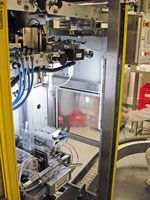Optimizing Development, Manufacturing, and Technology Transfer in the Outsourced Relationship
Successful product development and technology transfer between a CMO and the sponsor company requires a multifaceted collaborative approach. The author, Marga Vines from Grifols International, analyzes a project for an injectable drug for which a new drug application was submitted to FDA.
Successful product development and technology transfer between a CMO and the sponsor company requires a multifaceted collaborative approach. The author analyzes a project for an injectable drug for which a new drug application was submitted to FDA. The project required collaboration in development, manufacturing, and technology transfer; resource allocation of scientific and manufacturing staff; project management; and the resolution of related technical issues.

GrifolsA generic injectable drug was to be developed and manufactured in two strengths and supplied in flexible bags for sale in Canada, Australia, Europe, and the United States. The client planned to submit a new drug application (NDA) for FDA approval. This submission required demonstrating to FDA that the contract manufacturing organization (CMO), Laboratorios Grifols, was capable of manufacturing highly safe medicines of the quality demanded by the US market. The challenge of manufacturing a product that would be submitted for FDA approval involved adapting the existing quality system to FDA requirements.
All the CMO production facilities had implemented the same quality management system (QMS), and parametric release was authorized in 2007. The QMS includes European Medicines Agency (EMA) GMPs for medicines, ISO certifications, and FDA GMPs for medical devices. The challenge was to incorporate FDA GMPs for medicines into the QMS with as little upheaval as possible. The dilemma was adapting the QMS to FDA requirements concurrent to developing the medicine, which required teamwork between R&D, manufacturing, and quality assurance departments to, for example, improve master batch records, implement changes in manufacturing procedures, and improve deviation management.
Fortunately, the FDA inspection of the CMO’s facilities did not require the company to modify any of the production processes, other than those modifications already contemplated for the project. Some secondary non-crucial working procedures did require some adjustments, which were completed over a two-month period.
Establishing the team
One of the major hurdles required Grifols to be flexible and to incorporate the client’s requirements with a minimum impact to the company’s own structure and working procedures. This meant adapting to the customer without compromising the company’s own work philosophy. Third-party project management requires the same amount of dedication and commitment as for one of the company’s own products, because this is the only way to transmit integrity, inspire confidence, and establish clear and honest communication with the client.
Grifols needed to bring together a multi-disciplinary team of professionals. Each member of the team would have to be highly flexible and fully committed to the assignment; they would need to adopt a proactive attitude, have the ability to recognize the pitfalls that would inevitably arise, and provide adequate solutions. The first step was to decide upon a team that would guarantee agile communication with the client and that would respond effectively throughout the different stages of the project from the early development stages to placing the product in the market. The team included the following profiles:
- A galenic development technician (R&D) to develop the formula and the scale-up
- An analytical development technician (R&D) for development and for analytical-chemical validations
- A support technician for microbiological studies
- A technician with a management profile for quality control, contract management, inspections, and audits
- A technician with a management profile to provide support during the scale-up process, sterilization studies, and validations
- A negotiator able to handle contracts, client communication, and support at launch.
- In addition, top management needed to provide their full support and commitment to the project; top management played an important role in resolving strategic issues.
Planning the project
With the team in place, a schedule was determined for internal project follow-up and client communication. A crucial element was a project plan report to monitor progress on the milestones defined in a Gantt chart (a production control tool used in project management that provides a graphical illustration of a schedule to help plan, coordinate, and track specific tasks in a project). Another element was a global communications plan to review progress in the form of a twice-monthly meeting involving R&D, manufacturing, regulatory, quality, marketing, and project management teams.
In addition to this meeting, team meetings (between 2 and 4 each month) provided an update on the tasks being performed and helped identify any problems in the course of the project plan. Team meetings with the client (twice-weekly conference calls) were held to review the plan, make any adjustments, or introduce changes. In addition, management committees met as needed to make strategic decisions and evaluate changes that affected the initial planning.
These communication channels between the production areas (R&D, quality control, and manufacturing) and the client were vital to meet the tight schedule proposed by the client for launching the product in both the US and Europe, which involved a minimal time-to-market after FDA dossier approval.
Overcoming hurdles
Unexpected events can threaten to disrupt a schedule. At the initial stages of any project, particularly during the development phase, there is greater uncertainty in relation to how the latter stages will progress. The probability that problems will arise is also greater.
The first setback occurred during the analytical transfer due to the difficulty of the analytical methods. Grifols solved this by arranging for the customer to visit the facilities to make certain adjustments to the analytical methods in the high-performance liquid chromatography (HPLC) equipment.

Figure 1: A robotic palletizer deposits the product in autoclave trolleys. (All figures are courtesy of the author.)Later, when Grifols had already defined the manufacturing process, chosen the material to produce the bags, manufactured the lots to include in the registration process, and started the stability studies, higher levels of impurities than expected were detected during the first accelerated stability studies. The incident was reported immediately to the client, and both teams set to work to provide a solution to the dilemma.
Materials for producing the bag that had originally been ruled out for other reasons were reconsidered and ultimately proved more compatible. At the same time, investigations led to the source of the impurities. As a result, the entire project was overhauled: new tasks were incorporated, new protocols were designed, and additional studies were performed. Grifols was given a month to reschedule the project and adjust the budget. Both teams worked in synergy, maintained a positive outlook, and collaborated by generously offering human and technical resources to keep the project afloat. No one lost any time looking for culprits or making accusations; everyone got on with the job of finding solutions in a race against the clock.
Modifying manufacturing

Figure 2: An overwrapping system is used for double bagging the product.On the production side, two factories located 600 km (more than 370 miles) apart needed to be coordinated. The production lines at both factories, in Parets del Vallès (Barcelona) and Murcia, were modified to meet customer demands and ensure compliance to FDA regulations.
At the facilities in Parets del Vallès, where the end product is manufactured, a series of modifications were made. Artificial vision equipment was installed in the dosing line to control the primary bag and in the packaging area to control the correct insertion of the prospectus into the individual box, in compliance with FDA regulations. The robotic palletizer that deposits the product in autoclave trolleys was adapted prior to entering the terminal sterilization phase (see Figure 1). Due to the properties of the material used for double bagging the product, it was necessary to adapt the artificial vision equipment that transmits the coordinates to the automatic palletizer. Figure 2 shows the automatic overwrapping system used for double bagging. Other production processes, such as secondary packaging, are in the process of being automated. A single boxing machine that will be able to handle the required production for this customer will be installed.
Changes were introduced at the production plant in Murcia, where the primary bag and the twist-off valve are produced. In-line printers for the thermal images of the primary bag were modified to meet the labeling requirements for the different countries where the product will be sold. In addition, the twist-off valve mold was redesigned, and the corresponding validation was conducted. All these modifications required efficient coordination between the different production areas involved, so that they could be properly implemented on time.
Handling last-minute issues
A few weeks prior to launch, the regulatory authorities of one of the countries where the product was to be launched requested a full analysis of all the raw materials included in the first commercial lots. This request involved making an analytical transfer from the client to Grifols. Although the responsibility of the CMO was initially limited to the identification of the analytical profile index, the CMO adapted and undertook this additional step of raw material analysis to speed up the project.
Partnership leads to success
The difficulties that appeared during the course of the project did cause some delay, but because a margin of a few months had been planned, Grifols was able to manufacture and monitor the lots before the deadline. The client thus won the race against the clock and launched the generic product on the US market.
Marga Viñes is senior product manager of Grifols Partnership, a business area of Grifols International, Barcelona, Spain, marga.vines@grifols.com.

Pharmaceutical Tariffs Are Imminent: How Industry is Bracing for Impact
April 16th 2025On April 14, 2025, the Trump Administration launched a national security-driven investigation into pharmaceuticals, a move that will likely result in tariffs being placed on pharmaceutical drugs, ingredients, and other components that are imported from outside of the United States.
Drug Solutions Podcast: A Closer Look at mRNA in Oncology and Vaccines
April 30th 2024In this episode fo the Drug Solutions Podcast, etherna’s vice-president of Technology and Innovation, Stefaan De Koker, discusses the merits and challenges of using mRNA as the foundation for therapeutics in oncology as well as for vaccines.